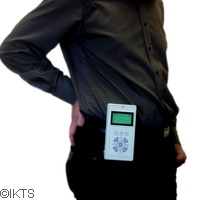Powering a beating heart: German researchers find innovative solutions for a new generation of pacemakers
While battery operated cordless devices dominate how we communicate today, their short power lifespan is a limiting factor when it comes to their application in medical settings, such as in implants or probes that are designed to stay in the body for many years and can't be taken out and charged like an mp3 player or a phone. Although this problem has largely been overcome with radio wave-based (HF) and inductive systems, such as pacemakers, which have been in use for the best part of half a century, there remain problems surrounding their efficiency in terms of location, position and movement and they are also often limited in range. Now, a team of German researchers, from the Fraunhofer Institute for Ceramic Technologies and Systems IKTS in Hermsdorf, has released details of their latest invention which they hope will go some way to overcoming some of these difficulties. They have come up with a new power transfer system, which has already been patented, to get around these location, position and movement limiting factors that currently plague radio wave-based (HF) and inductive systems. The team successfully managed to wirelessly transmit power from a portable transmitter module to a mobile generator module or 'receiver'. The transmitter provides an electric current of over 100 milliwatts and has a range of about 50 centimetres. As a result, the receiver can be placed almost anywhere in the body. Dr. Holger Lausch from the Fraunhofer Institute for Ceramic Technologies and Systems IKTS comments: 'The cylindrical shaped transfer module is so small and compact that it can be attached to a belt. With our portable device, we can remotely supply power to implants, medication dosing systems and other medical applications without touching them - such as ingestible endoscopic capsules that migrate through the gastrointestinal tract and transmit images of the body's inside to the outside.' The generator module can be traced any time - regardless of power transfer - with respect to its position and location. So if the generator is located inside a video endoscopy capsule, the images produced can be assigned to specific intestinal regions. If it is placed inside a dosing capsule, then the active ingredient in the medication can be released in a targeted manner. In the transfer module, a rotating magnet driven by an EC motor generates a magnetic rotary field. A magnetic pellet in the receiver connects to the alternating exterior magnetic field and as a result, is set in rotation itself. The rotational movement is transformed into electricity, thus the power is produced right in the generator module. Dr Lausch discusses the systems' advantages: 'With magnetic coupling, power can be transported through all non-magnetic materials, such as biological tissue, bones, organs, water, plastic or even a variety of metals. Moreover, the magnetic field produced has no harmful side effects on humans. It doesn't even heat up tissue.' These new types of miniature, intelligent systems are set to soon take over therapeutic and diagnostic functions. Scientists hope that in the future implantable sensors will be able to measure glucose levels, blood pressure or the oxygen saturation of tumorous tissue, as well as transmit patient data via telemetry, a technology that allows measurements to be made at a distance, via radio wave or IP network transmission and reception of the information. As the modules available as prototypes are scalable in terms of range, size and performance capacity, they can also be used for more than medical technology applications. They can also supply power wirelessly to hermetically sealed sensors - such as those inside walls or bridges. Therefore this makes them suitable for use in mechanical engineering and plant construction. In the future they could also be used for charging power storage units and activating electronic components.For more information, please visit:Fraunhofer Institute for Ceramic Technologies and Systems IKTS:http://www.ikts.fraunhofer.de/en/
Countries
Germany



